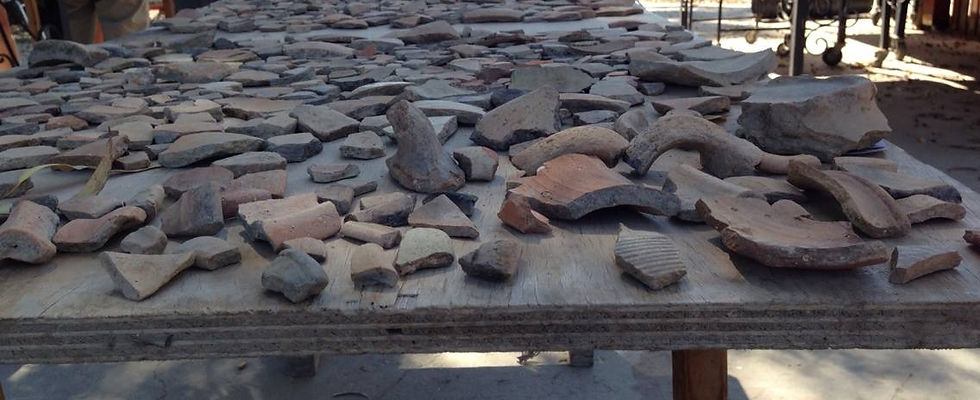
What is Entailed in
Archaeological Artifact Analysis?

What is Archaeological Artifact Analysis, and Why Does It Matter?
Archaeological artifact analysis is the scientific investigation of historical objects—from everyday tools to ceremonial relics—to uncover their meaning, function, and connection to past societies. Artifacts serve as silent witnesses to history, capturing technological advancements, trade networks, and cultural traditions.
The Growing Demand for Artifact Analysis
Understanding artifacts isn’t just for academic research—it’s crucial for:
-
Museums & Cultural Institutions curating accurate historical narratives.
-
Government & Tribal Organizations ensuring heritage compliance and ethical preservation.
-
Private Collectors & Researchers verifying authenticity and historical significance.
-
Sometimes companies or institutions might bite off more than they can chew with incomplete projects or an institution or individual inherits a large collection left in boxes for decades without inventory.
As heritage preservation expands, the demand for precise artifact analysis increases—whether for legal documentation, public exhibitions, or scholarly research. HAR ensures artifacts aren’t just labeled, but truly understood.
What methods does HAR use for artifact analysis?
We do not do material analysis (XRF, petrographic examination, SEM), microscopic, or residue testing. Though we apply:
-
Typology & Classification (seriation) – Sorting artifacts by material, function, and cultural style.
-
Spatial & Environmental Analysis – Mapping artifact distributions to interpret site activity areas and trade networks
Artifact Analysis Steps
-
Cleaning artifacts, brushing, picking, washing, drying, as needed
-
Sorting artifacts
-
Documenting individual artifact properties and measurements
-
Photographing artifacts, as needed
-
Classification/Identification
-
Cataloging
-
Analysis
-
Report writing on results, if applicable
-
Data visualization and proof reading
-
Additional stewardship, curation, or interpretation advice, if applicable
Artifacts hold layers of history, and HAR ensures those layers are unraveled with expertise and care.
How Does Artifact Pickup And Submission Work?
HAR makes artifact analysis accessible and flexible:
-
Local Pickup (Free!) – If artifacts are within 45 minutes of Cedar Park, TX, HAR will pick them up at no charge.
-
Mail-In Submissions – Clients can securely ship artifacts for analysis.
-
Photo-Based Evaluations – Some artifact types may be analyzed via high-resolution images, reducing logistical needs.
Let’s determine the best submission method based on the artifact type and project scope. We will need bags of the artifacts (assuming they came with some with the collection unit details) and also need data associated with the finds and any provenience data, field record data, report (even if draft) or existing research design (if available), any remarks about field biases, previous artifact treatments, and the story about how it came to your possession and your goals. If there are particular catalog formats or spreadsheets or forms to have the identification and analysis compiled into, we will need that too. All this will ensure the surrounding context is furnished to write produce the best deliverable for the client.
How much time should I expect artifact identification to take?
The total hours required depend on both the number of artifacts and the diversity of artifact types needing analysis.
Why Choose HAR’s Artifact Analysis Over Other Services?
HAR takes artifact analysis beyond basic categorization, offering:
-
Interdisciplinary Expertise – Integrating archaeology, UX research, and business analytics for holistic interpretations.
-
Custom-Tailored Insights – Going beyond identification to uncover deep cultural and historical narratives.
-
Photographic Documentation for Research & Display – High-quality visual documentation for public exhibitions, academic studies, and artifact preservation records.
-
Basic Cleaning for Proper Analysis – Every artifact undergoes surface-level soil and debris removal to ensure clarity in classification.
-
Accessibility Perks – Free local pickup, flexible submissions, and structured discounts for long-term research projects.
What HAR's Artifact Analysis Does Not Do!
-
We do not perform detailed conservation work on fragile artifacts, we do basic cleaning for identification purposes (dust, soil, and light surface corrosion removal) but not stabilization/curation purposes.
-
We do not perform antiquities value appraisals! Though, we can make identifications and assess authenticity.
-
We do not purchase or sell artifacts.
-
We do not curate artifacts.
-
We do not perform advanced material analysis, microscopic, genetic, paleoethnobotanical remains, or residual analysis.
What does HAR consider Artifact Classes?
Since an above table make certain client cost estimates based off major artifact classes and total number of artifacts, the reader may be curious to know what is meant by a major artifact class. It's important because its more efficient to identify like artifact classes together with its attendant references still out. Here is a list:
-
Lithics (stone tools and debris)
-
Ceramics (Pottery and clay objects)
-
Metal Artifacts (implements, weapons, coins, hardware)
-
Faunal Remains (animal bones and shells)
-
Floral Remains (seeds, charred wood, pollen)
-
Misc. Organics (textiles, carvings, leather goods)
-
Glass (beads, bottles, vessels, containers, shards, window glass)
-
Architectural Remains (bricks, tiles, plaster, mortar, wooden beams)
-
Human Remains
-
Composite Artifacts: (witch's bottle, inscriptions, manuscripts, seals, bundles)
